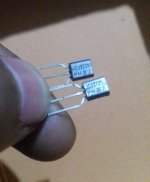Hi everyone,
I bought a Hiraga MC board with BC560C instead of original 2SB737R and I have a lot of noise
I bought also a Hirage 30W boards with BC550C BC560C instead of 2SC1775A 2SA872A and a also have a little noise
My question is are BC550 BC560 low noise?
I bought a Hiraga MC board with BC560C instead of original 2SB737R and I have a lot of noise
I bought also a Hirage 30W boards with BC550C BC560C instead of 2SC1775A 2SA872A and a also have a little noise
My question is are BC550 BC560 low noise?
The BC550 and BC560 were lower noise than BC547 and BC557 but never the lowest on the market. 2SB737 and 2SD786 were much lower noise. Note the 2 Ω (typical) base resistance of the 2SB737 vs >130 Ω for the BC560. In a well-designed low-noise amp the base resistance is the dominant noise source.
Tom
Tom
Its all relative. BC550C/BC560C are indeed low noise but the 2SB737 in particular is very low noise ie about the lowest you can get.
sorry tomchr's post crossed mine
sorry tomchr's post crossed mine
Reasonably, but not very low noise; probably not good enough for MC. Their base resistance is quite high for a MC amplifier, unless you use many of them in parallel.
I don't think anybody has beat the 2SB737. I'd stick that back in and move on.
Tom
Tom
If you believe the measured data by Horowitz and Hill (The Art Of Electronics, 3rd Edition), there are several current-production BJTs with lower measured base resistance than the 2SB737. These also have lower measured noise voltage density [nV/sqrtHz] than the 2SB737.
See the bottom ~8 rows of table 8.1a on page 501.
H&H very kindly reveal their noise measurement test fixture too. It's Figure 8.92 on page 557.
See the bottom ~8 rows of table 8.1a on page 501.
H&H very kindly reveal their noise measurement test fixture too. It's Figure 8.92 on page 557.
See also https://www.diyaudio.com/community/threads/has-anyone-used-these-gems.92901/post-5034251 and the rest of that thread.
Cool. How low base resistance are they reporting? I have many books. AoE is not one of them.If you believe the measured data by Horowitz and Hill (The Art Of Electronics, 3rd Edition), there are several current-production BJTs with lower measured base resistance than the 2SB737.
Tom
Very long ago we already used BC327-25 (or the 40) and BC337-25 (or the 40) as they were lower in noise when compared in real life to BC550C/BC560C. All made by Philips, I don't know of other brands.
Rbb is below 50 Ohms AFAIK.
Rbb is below 50 Ohms AFAIK.
Last edited:
I read page 501, the art of electronics by Horowitz.
So the winners in his measurements for lower noise are ztx851/951 ?
So the winners in his measurements for lower noise are ztx851/951 ?
The lesson maybe is that popular does not necessarily means anything with regards to quality, words/marketing not always tell the truth and perceived reputation stays for a very long time 🙂 Also the other way around like with tantalum caps that today are very good but often get ridiculed for being totally unreliable (which was true many decades ago with drop types).
One sees countless designs for decades that use BC550C/BC560C with proud mentioning them to be low noise transistors (which is true when one draws a certain line below a certain noise level but then many are low noise). The story always mentioned about BC327/BC337 is that they are higher in allowable current (which is true but it is not their sole forté). No experience with the Zetex ones as I rarely use discrete semis anymore but from paper they seem superior.
In fact it seems reasonable to call BC550C/BC560C high noise transistors and to avoid these completely 😀
One sees countless designs for decades that use BC550C/BC560C with proud mentioning them to be low noise transistors (which is true when one draws a certain line below a certain noise level but then many are low noise). The story always mentioned about BC327/BC337 is that they are higher in allowable current (which is true but it is not their sole forté). No experience with the Zetex ones as I rarely use discrete semis anymore but from paper they seem superior.
In fact it seems reasonable to call BC550C/BC560C high noise transistors and to avoid these completely 😀
Last edited:
Those 550/560 works well as (supposed) 'low noise' as long as the source impedance is low (shorting the 550/560 base resistance). Suitable in medium to higher power amplifiers, but if the input is cap-coupled, one can detect the dark 1/f noise.
But on demanding MC-levels, they're not a prime choise indeed.
But on demanding MC-levels, they're not a prime choise indeed.
Many modern SMD opamps have way better properties in more than a few areas when compared to circuits based on old discrete through hole semis. A probably undesired truth that will give equally undesired feedback but nevertheless...
The base resistance is usually in series with the source impedance. I don't see a way of shorting it. Or maybe we're talking about two different things? I'm thinking of a common emitter stage.Those 550/560 works well as (supposed) 'low noise' as long as the source impedance is low (shorting the 550/560 base resistance).
Tom
The source and the base resistance are in series. For low-Z source (MC phono) the base resistance dominates.Those 550/560 works well as (supposed) 'low noise' as long as the source impedance is low (shorting the 550/560 base resistance).
- Home
- Amplifiers
- Solid State
- BC550 BC560 are low noise?
